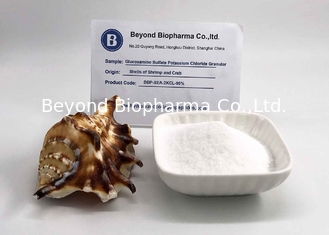DC Grade Glucosamine Sulfate Potassium Chloride Granular for Direct Table Compressing
We are able to supply DC Grade D-glucosamine Sulfate Potassium Chloride granular which could be used for Direct Tablet Compressing.
Glucosamine is a compound in which a hydroxyl group of glucose is substituted by an amino group. It is an important component of a highly hydrophilic proteoglycan, an important nutrient for forming chondrocytes, and an essential component of cartilage matrix and joint fluid. Glucosamine is an important precursor in protein or lipid glycosylation reactions. Glucosamine can be synthesized in the human body and can be used as a substitute for endogenous articular cartilage nutrients.
Detailed features of D-glucosamine sulfate 2KCl supplied by Beyond Biopharma
| Material name |
D-glucosamine sulfate 2KCL DC Grade Granular |
| Origin of material |
Shells of shrimp or crab |
| Color and Apperance |
White to slight yellow powder |
| Quality Standard |
USP40 |
| Purity of the material |
>95%, PVP K30 / HPMC K30 |
| DC Grade |
Granulated Granular for Direct Tablet Compressing |
| Particle Size |
30-40 mesh |
| Moisture content |
≤1% (105°for 4 hours) |
| Bulk density |
>0.7g/ml as bulk density |
| Solubility |
Perfect solubility into water |
| Application |
Joint care supplements |
| Qualification docs |
NSF-GMP |
| Shelf Life |
2 years from production date |
| Packing |
Inner packing: Sealed PE bags |
| Outer packing: 25kg/Fiber drum, 27drums/pallet |
Typical Specification of Glucosamine Sulfate 2KCL
ITEMS
|
SPECIFICATION (TEST METHOD) |
RESULT
|
| Appearance |
White to off-white powder |
Visual |
| Identification |
A.Infrared Absorption (197K)
B: It meets the requirements of the tests for chloride and potassium. (191)
C: The retention time of the major peak in the chromatogram of the Assay preparation corresponds to that in the chromatogram of the Standard preparation, as obtained in the Assay
D:In the test for Content of sulfate, after the addition of barium chloride TS a white precipitate is formed
|
USP40 |
| Assay |
≥ 95% (On dry basis) |
HPLC |
| Specific Rotation |
47°- 53° |
<USP781S> |
| PH (2%,25°) |
3.0-5.0 |
<USP791> |
| Loss on drying |
Less than1.0% |
<USP731 |
| .Residue on Ignition |
26.5%-31%(dry base) |
<USP281> |
| Organic Volatile Impurities |
Meet requirements |
<USP467> |
| Sulfate |
15.5%-16.5% |
<USP221> |
| Sodium |
A solution (1 in 10), tested on a platinum wire, does not impart a pronounced yellow color to a nonluminous flame. |
USP40 |
| Bulk Desity |
0.60-1.05g/ml |
In-house Method |
| Heavy Metal |
NMT10PPM |
(Method I USP231) |
| Lead |
NMT 3PPM |
ICP-MS |
| Mercury |
NMT1.0ppm |
ICP-MS |
| Arsenic |
NMT3.0PPM |
ICP-MS |
| Cadmium |
NMT1.5PPM |
ICP-MS |
| Total Bacteria Count |
<1000CFU/g |
<USP2021> |
| Yeast & Mold |
<100CFU/g |
<USP2021> |
| Salmonella |
Negative |
<USP2022> |
| E.Coli |
Negative |
<USP2022> |
| Staphylococcus Aureus |
Negative |
<USP2022> |
| Particle size |
30-40 mesh |
Pass |
| Storage: 25kg/drum, keep in an airtight container, protected from light. |
The advantage of our DC Grade D-glucosamine sulfate 2KCl ?
1. We provide Customized production for you: Tell me your requirements, we will produce according to your requirements such as particle size, purity, bulk density etc.
2. We have both Shellfish origin available and Fermentation vegan origin availble for your choice
3. GMP Manufacturing Facility. Our production facility is GMP verified and and Good QC Laboratory.
4. Professional Sales Team. We have professiona sales team to deal with your inquires.
Glucosamine and Joint cartilages Health ?
Glucosamine is an amino sugar in the body, which is found in cartilage and connective tissue. It is the main component of the joint lubrication structure of the human body and is also a necessary substance for the formation of chondrocytes.
Both humans and animals can synthesize glucosamine in the body, but as the age increases, the rate of biosynthesis gradually slows down to the rate of decomposition, and the phenomenon of glucosamine deficiency in the body and joints occurs. The lack of glucosamine affects the metabolism of chondrocytes in the joints, resulting in less and less nutrients supplied to the cartilage tissue, making the thickness of the cartilage tissue thinner, and the joint surface is not smooth, rough, and aging, resulting in bone hyperplasia.
The lack of glucosamine causes a lack of lubrication of the joint cavity between the joints, causing the aging joints to rub against each other, causing pain, causing a series of symptoms and signs such as osteoarthrosis and progressive cartilage degradation seen daily.
Supplemental glucosamine can replenish joint lubrication fluid, provide the necessary materials for joint recovery and cartilage tissue damage after damage, restore the physiological function of degraded cartilage and promote chondrocyte production, and repair degenerative joint damage. At the same time, the addition of glucosamine can also increase the fixation of bone tissue to calcium. Avoid calcium loss and increase bone density.

 Your message must be between 20-3,000 characters!
Your message must be between 20-3,000 characters! Please check your E-mail!
Please check your E-mail!  Your message must be between 20-3,000 characters!
Your message must be between 20-3,000 characters! Please check your E-mail!
Please check your E-mail! 




